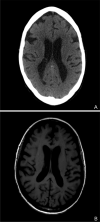Code Pseudo Stroke - A Case of Hypokalaemic Periodic Paralysis Mimicking Stroke
- PMID: 37455687
- PMCID: PMC10348440
- DOI: 10.12890/2023_003947
Code Pseudo Stroke - A Case of Hypokalaemic Periodic Paralysis Mimicking Stroke
Abstract
We present a case of thyrotoxic periodic paralysis (TPP) presenting with stroke symptoms as a harbinger of Grave's disease. A 61-year-old female presented with symptoms of abdominal pain and fatigue two weeks prior to admission and reported acute diarrhoea and unintentional weight loss. Investigation revealed thyrotoxicosis with undetectable thyroid stimulating hormone (TSH), elevated free T4 and elevated thyroid stimulating immunoglobulin (TSI). On the third day of admission, while undergoing physical therapy, code stroke was called on account of the onset of right-side predominant acute flaccid paralysis of upper and lower extremities, right-side facial droop, dysarthria and hyporeflexia bilaterally. The patient was alert and fully oriented with stable vitals with no increased labour in breathing at room air. An emergent head and neck CT, angiography, and magnetic resonance imaging (MRI) were negative. Serum potassium was 2.7 mmol/l, requiring prompt replacement. The patient's paralysis and dysarthria improved over the following three days with a complete reversal of symptoms following the correction of serum potassium. Thyrotoxic periodic paralysis can occur in association with any of the causes of hyperthyroidism. It is due to a significant intracellular shift of potassium, subsequently manifesting clinically with hypokalaemia and muscle paralysis.
Learning points: Hypokalaemic periodic paralysis is an acute flaccid paralysis secondary to hypokalaemia, triggered by hyperthyroidism, environmental elements such as a high carbohydrate intake or rest after intense exercise, and an underlying genetic component with mutations in the muscle ion channels.The pursuit of code stroke protocol in the in-patient setting must bear in mind reversible but potentially fatal and disabling alternative diagnoses such as stroke mimics including hypokalaemic periodic paralysis.Stroke mimics defined as acute onset neurological deficits that are not related to vascular cause are a true challenge, multiple scales have been created to distinguish them from an actual stroke, such as the Recognition of Stroke in the Emergency Room (ROSIER) scale.
Keywords: Hypokalaemic periodic paralysis; pseudo stroke; stroke mimics; thyrotoxic periodic paralysis; thyrotoxicosis.
© EFIM 2023.
Conflict of interest statement
Conflicts of Interests: The Authors declare that there are no competing interests.
Figures


References
-
- Lin S-H. Thyrotoxic periodic paralysis. Mayo Clin Proc. 2005;80:99–105. - PubMed
-
- Antonello IC, Antonello VS, de Los Santos CA, de Almeida N, d’Avila DO. Thyrotoxic hypokalemic periodic paralysis: a life-threatening syndrome. Eur J Emerg Med. 2009;16:43–44. - PubMed
-
- Kilpatrick RE, Seiler-Smith S, Levine SN. Thyrotoxic hypokalemic periodic paralysis: report of four cases in black American males. Thyroid. 1994;4:441–445. - PubMed
-
- Ober KP. Thyrotoxic periodic paralysis in the United States. Report of 7 cases and review of the literature. Medicine (Baltimore) 1992;71:109–120. - PubMed
LinkOut - more resources
Full Text Sources
